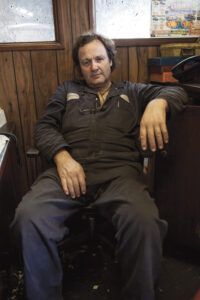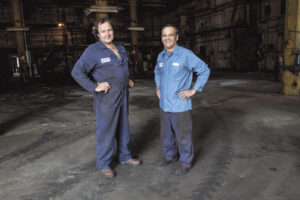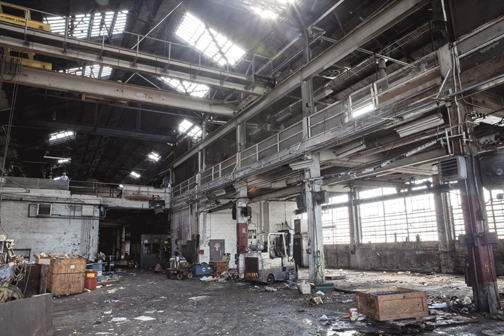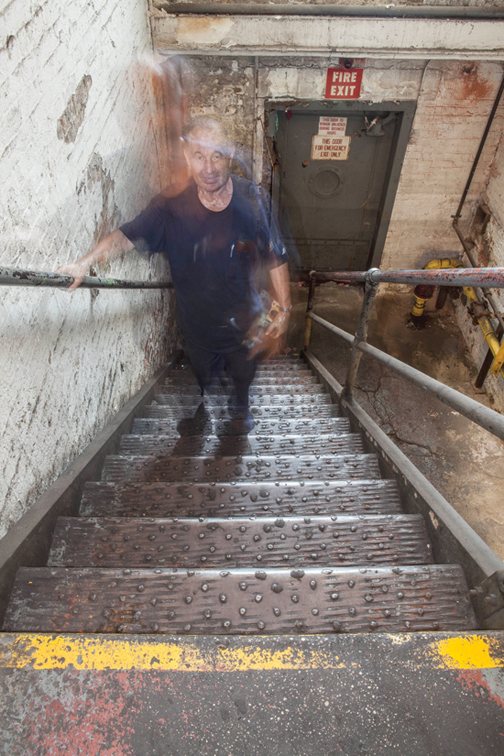For 60 years, the ruckus of machines and tools rang though Golten Marine’s machine shop at 160 Van Brunt.
A hive of mechanics and workers toiled for long hours as they rebuilt engines and drive systems of ships and tankers stranded throughout the world.
Even when it was quiet, an air compressor’s hiss rang through the workshop.
On July 3, Goltens went silent, the building sold to LIVWRK, a developer with plans to convert the industrial space into office and creative spaces.
For the employees of Goltens – many of whom spent their careers covered in the building’s grease and grime – the closing hurts. Not because on April 4th, they lost their jobs. Not because they lost their income. Because they lost their family.
Since then, the same guys who spent years mending and repairing damaged ship parts have been dismantling their second home.
Edik Fishman, a jack-of-all trade with 17 years of Goltens experience was decommissioning the machine shop’s electrical system. While he slowly climbed the studded, grease-caked stairs to the light-soaked second floor, the 70-year old with a grey stubbly beard and smears of grease on his cheeks paused to impart words of advice.
“Have more than one child. Who does my son have after I am gone?” he lamented. “He is alone.”

Like losing a family member
For the employees of Goltens, shuttering the facility is like losing a family member.
On some nights, when 2nd shift would finish, rather than head home to their families or to the neighborhood bars, the guys would stay together at the shop.
“Friday nights was poker night,” said Sandro Morelli, 66, who originally worked on the night shift. “We would wash up, have sandwiches and play poker until the morning. Just a friendly game to stay together with the people you were working with. Those [nights] I miss,” he said.
For 48 years, Sandro worked for Goltens, He started in 1966 at Noro Incorporated, a non union shop in New Jersey. His job moved to the company’s unionized Red Hook facility on Van Brunt in 1968, where he worked until retiring in as the Machine Shop Supervisor in January 2014 but temporarily brought out of retirement to help close down the shop.
Sandro remembers his first day on the job like it was yesterday. “When I first came here and walked through that door at 9:30 in the morning, everybody in the place spoke a foreign language. We thought Brooklyn was part of America, but we came over here and we couldn’t understand a damn thing. That’s how it started,” he joked.
Even today the few remaining workers cleaning up the space maintain that internationality. The General Manager’s originally Croatian, the Service Engineer from Spain, Business Development Manager from India, other workers are from Ukraine and South America.
“Most of our work force was from other countries,” said Shari Umland, the Human Resource manager who worked for Goltens for 25 years and from time to time brought her son to work with her. “We had a big diverse background of employees in the shop.”
Over time, as workers retired they’d be replaced by employees from new countries.

In the 60s the employees were Scandinavian: from Denmark, Norway, Sweden and Finland. In the subsequent years, came the Italians, followed by Greeks and lately, a lot of Russians, Sandro said.
But finding qualified mechanics proved a challenge as the remaining staff approached or surpassed retirement age in their 60s and even 70s.
“We weren’t able to find the type of engineers we needed. Nobody’s going to school for this – it’s such a specific type of engineer. That’s why a majority of our workforce was international,” Shari said. “It was such a diverse employee base in the shop. I always picked up a few words of every language. It was great.”
Ivo Sisic’s commute from Long Island took 55 minutes. He’d arrive at Goltens at 5am or ten after five at the latest, he said. He worked his way up the ladder and when the workshop shut down in April, was running the facility as its General Manager.
“I’m devastated. When you spend 42 years here, that’s all your best years. Now it’s over. It’s over,” he said with a Croatian-clipped accent.
Casualty of a changing industry
“I would say in the 90s things started going down and down and down,” Ivo said. The 70s were booming: 120 ships docking every day in New York Harbor. Today that number is 13 ships on average, he added.
The decrease in the number of ships docking in New York coupled with newer and bigger vessels that require less maintenance meant less work for Goltens’ mechanics. In response, the company slowly trimmed their workforce down to 20 employees; the number let go on April 4.
An international enterprise
Not all of Goltens’ business came from the New York Harbor. The company routinely sends crews throughout the world to repair ships. Juan Cadabel, originally from Spain, is one of the Service Engineers with experience working on fishing boats, container ships, passenger ships, tankers and routinely travels to repair vessels. He knows how tough working on ships can be. “Four days I [worked with] no sleep,” he said. “This is my record. Day and night.”

Ships still need repairs but in today’s market but they “come in the morning and leave in the evening and [there] is no time to do anything,” Ivo said. “An owner will not repair the ship in New York. They will repair the ships in the Far East where it is much cheaper.”
Repairs cost a fraction of the price in places like Singapore and China, where Goltens also operates, Ivo said.
“We were only surviving on emergency repair. If the ship cannot leave, we can repair it. That’s how we survived through the years,” Ivo said.
“It’s a sad commentary on the maritime industry. It has struggled for the last 30 years. Goltens was always a bedrock of the industry. With Goltens gone, it leaves an empty space in the New York Harbor and in the United States,” said Dean Couphos, the Operations Manager (#2 at the Red Hook facility) with 35 years of ship repair experience including 8 years at Goltens.
“It’s sad because this is where they started. This is where they made their money to get to where they are now,” Sandro said.
Began on Carroll Street
Goltens was founded in 1940 by Sigurd Golten. Their first shop was on Carroll Street. The company grew and eventually bought the 100,000 square foot Red Hook building in 1945. As business grew, Goltens expanded and now operates in 25 cities in 15 countries and remains a family owned and operated company focusing on marine repairs, maintenance, reconditioning and engineering components.
“Goltens is a family business. Its roots are in Brooklyn,” said Roy Strand, the Vice President of Goltens Americas and Goltens Europe, and the grandson of the company’s founder. “We’ve been in Brooklyn almost 75 years, but when we looked at the economics and the long-term viability of where we were doing business, we decided it was time to consolidate our operations. It was a tough decision.”
“If the old man [Sigurd Golten] knew this was going on, he would be turning over in his grave right now,” Sandro said. “But what are you going to do?”
In the United States, Goltens has facilities in Miami and is relocating much of the machinery to a workshop being built in Houston. Lathes, drilling machines, drills, babbit machines, even a 40- foot long grinding machine were packed up and sent to repair shops throughout the world: Rotterdam, Oslo, Singapore, Vietnam, Miami, Houston.

Everything left over was scrapped, thrown out or sold at auction.
But not Sandro’s toolbox. For a mechanic, tools are the key to his livelihood, prosperity, and for Sandro, a window into the past. His toolbox was full of gifts. Tools from retired Goltens employees given to him as “something to remember me by,” he said. “A few of them I took home. A socket wrench just to remind me of the people I was associated with for so many wonderful years.”
Like any family, the crew at Goltens had its share of tribulations. Taped to the back of a door in the upstairs office are photos of downtown Manhattan taken on 9/11, moments after the towers were attacked.
“On the roof we had such a beautiful view of the Twin Towers,” Shari said. “I was sitting at my desk, listening to the radio when one of the planes hit. I went out onto the roof with a colleague. We saw the buildings just falling. There were military [soldiers] outside in gas masks. It was snowing from all the debris from the buildings coming down. It was surreal,” she said.
The shop stayed closed for the rest of the week, but when it reopened Shari, like all New Yorkers, proved her resilience and went back to the roof. “I couldn’t believe the buildings were not there,” she said.
Hurricane Sandy also took a toll on Goltens. “We took a beating with the storm,” Sandro said as he pointed to a mark six-feet high on the wall. A garage full of reconditioned parts was underwater as were all of their machines. Luckily they were able to salvage and repair most of the storm-damaged parts and machines and continue using the space.
In the past few years, the shop caught the film and music industry’s attention. An episode of The Americans was filmed there, as was a Duncan Sheik video, and the movies: Analyze That and Extremely Loud & Incredibly Close were both shot there. Sandro was an extra in both movies.
Today, the space is empty, a few odds and ends scattered around waiting to be tossed out. A piece of paper from 2002 lists the employees and their seniority. Signs nailed to the grease-stained brick walls promote workplace safety. The machines are all gone.
“Now it’s like a cave. We had so much machinery here. [At one time] we were running 24-hours a day, 7-days a week. It was always noisy from hammering, machining. Now it is like a ghost,” Ivo said.
“I can’t believe I’m not going to be here anymore,” said Shari, the employee of 25 years. “You go through the phases of: you’re upset, you’re mad. Now I’m done. I’m happy. Change is good, but the thought of change is scary. Everything changes, but we had a good run.”









5 Comments
Thanks for all of your hard work, New York!
hola Ivo remember I a mexican….
Good times to remeber gr from goltens rotterdam
Wow such great historical information. I now work in the building helping repair it and it is now a Tesla building
Thanks! It has a great history – enjoy the photos!